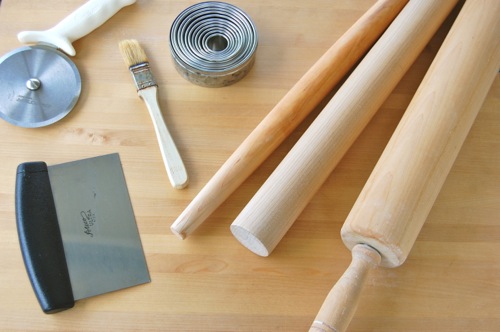Gear Essentials: Shaping

The “shaping” step, for some kinds of pastry, can be extremely involved. However you can do a heck of a lot with just the implements you see here (starting with the background of this and every Joe Pastry photo: a nice, solid maple board). The bench scraper on the bottom left is something most home bakers don’t own, but is invaluable for scraping up sticky bread doughs, portioning dough for rolls, cutting the ends off jelly rolls, the list goes on.
You’ll notice the three pins I own. The tapered one is French, useful for light-duty jobs that need finesse. The cylindrical one is an Asian-style, which is my go-to all-around pin. The big honking’ German pin is what I use to roll large quantities of laminated dough. It’s fabulous for any job that requires extra muscle.
Of course once that dough is portioned and rolled, you usually need to trim or cut it. The pizza cutter and round cutter set will take you far in that department. I couldn’t find my little biscuit cutter for this shot, but it belongs there. Of course you can buy cookie cutters in a million custom shapes. I have quite a few holiday shapes, but then I only use them once a year!
The pastry brush isn’t about “shaping” strictly speaking, but then shaping is the step that you generally apply the melted butter or egg wash. I’ve had that little one for years and it’s all I really need.
I really like my silicone pastry brush. So easy to clean and no worries about ‘hairs’ in your food.
I have a variety of baskets for shaping slack doughs for bread. You can place a well-floured towel in to act as a quick release and fold the ends over to keep it hydrated while it proofs. I’ve sewn in linen sleeves to my most often used ones.
Baskets (bannetons if you like) are fun because they will imprint charming patterns onto the crust of the bread while supporting the mass. I have some open work metal ones I use for just that reason. I also use some cheapy red plastic ones — the kind you get in a diner lined with a square of parchment when you order french fries or fish and chips — that I use for small loaves.
Don’t forget the importance of those well-floured and, ideally linen, towels. You can “couche” dough in them, roll out pastry on them, knead biscuit dough on them, shape baguettes and use them to transfer sticky dough. You don’t ever need to wash them. Just shake them out and keep flouring them. They might stick a bit at first (just let the dough dry and flick it out) but after a time or two they become bakers’ teflon.
Ikea is a good source for inexpensive linen towels and heavy weight cotton ones.
Thanks Rainey! Great advice for the bread maker!
– Joe
I have a French rolling pin that I could never live without. I first started using it in Pastry School and bonded with it forever-after. I find it so versitile because I feel that I can control where I role the dough depending on where I put the pressue. I often use one end to roll out a portion of dough that is too thick or difficult rather than the middle or whole rolling pin. I also have a few handled rolling pins that are vintage as well as a new silicone covered one and a tapered end wooden one. Still… I always go back to my faithfull French Rolling pin.
Do you think a marble rolling pin would be a good idea? I really want to start making croissants and other pastries, possibly for my small-scale baking business but also just for fun, and the French pin I own, while wonderful for many things, is just not up to the challenge (or perhaps my arms are not up to the challenge!). I’ve seen very heavy marble pins, and while they seem like they might be a good idea, they also seem terribly unwieldy and expensive. Thoughts?
Hi Meg! It’s not true that you need marble for laminated pastry. I’ve been in the back of more than a few pastry shops and I’ve never seen that kind of gear. I was the regular dough laminator at a pastry shop I once worked at, and like everyone else I just used a big wood pin and a big wood board. Granted that there are automated rolling machines for baking operations that need dozens of pounds of laminated dough per day, but those are really designed for lamination at an industrial scale.
Sometimes on TV you see pastry chefs with marble countertops and marble pins, their blocks of dry ice issuing dramatic clouds of CO2. Home bakers need none of that…just practice. Wood is all you need, just get something big and heavy. 😉
– Joe
Great post! Great blog!
I do have a “marble” as part of my pastry shaping arsenal. Its a large slab of granite counter top remnant. I was able to get it discounted because of it’s remnant status. I attached round thick felt pieces to the back (the type meant for furniture legs) to prevent it from scraping up my counter top. It’s stored on top of my refrigerator until needed. It’s perfect for rolling out pastry doughs and tempering chocolate at home.
I have nothing against them of course, Jen. When they’re handy they’re handy. And everyone likes different gear.
Thanks for the comment!
– Joe